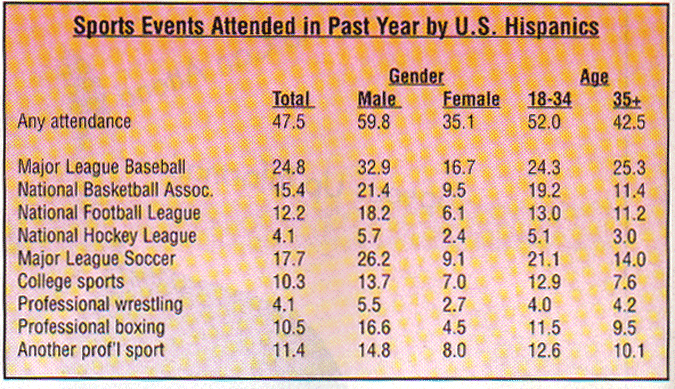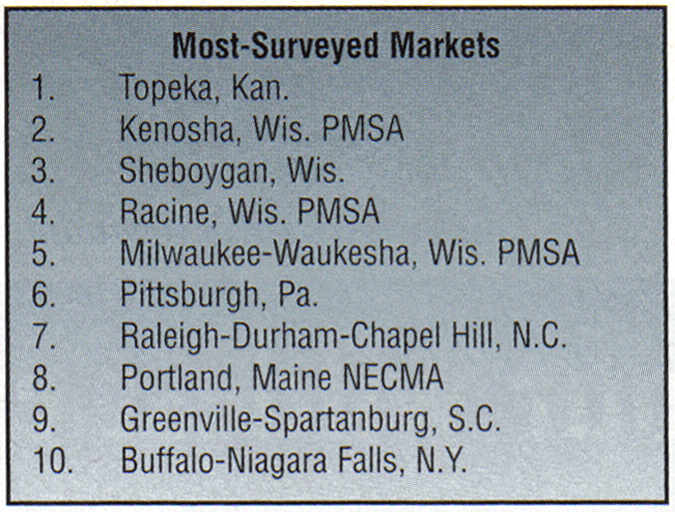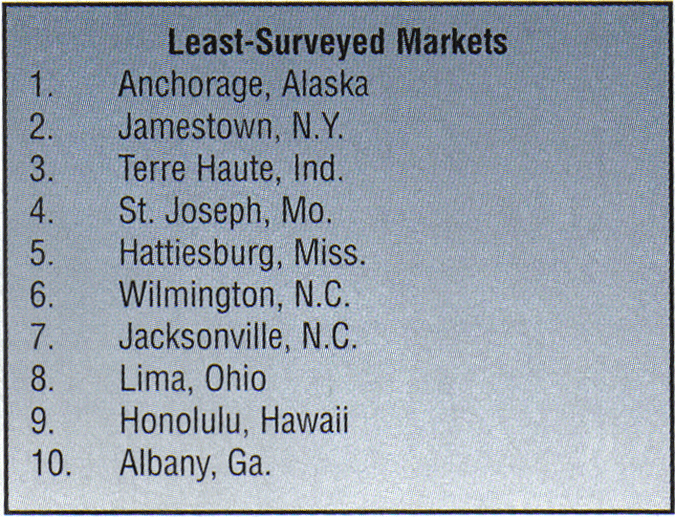Hispanics love sports
In a recent issue of Inside Strategy, a newsletter from Strategy Research Corp., Miami, Raul Lopez, the company’s senior vice president, reports on findings from Strategy’s "1998 U.S. Hispanic Market Study" showing that Hispanics are big sports fans. In the study, almost two out of every three respondents reported that professional spectator sports were either "extremely" or "somewhat" important (Top Two Box Score). Almost half, (48 percent) of all respondents indicated that they had been to a sports event in the past year, and nearly haft (49.7 percent) of all Hispanics reported having listened to sports events on the radio in the past year.
The study also found that Hispanics attend a series of sporting events, with almost half (48 percent) of all respondents indicating that they had been to a sports event in the past year. Among Hispanic males, roughly 60 percent or three out of every five, had attended some event.
The two most-attended sporting events for the total Hispanic market and for males as a separate group were Major League Baseball, with nearly one quarter (24.8 percent) of Hispanics having attended a game in the past year, and Major League Soccer (17.7 percent).
Nearly the same percentage of women attended basketball games (9.5 percent) as soccer games (9.1 percent). This is slightly different from the male percentages which favored soccer (26.2 percent versus 21.4 percent).
Attendance to individual sports categories provided some interesting data, when looked at by country of origin of the respondent. Mexicans, traditionally considered soccer fans, are apparently also big baseball fans. Roughly 23 percent reported having been to a Major League Baseball game; this compares to 16 percent for soccer.
Baseball was by far the event of choice among respondents from the Dominican Republic, where 45.5 percent reported having attended at least one game in the past year. Further, baseball was also the sport with the highest pastyear attendance among Puerto Ricans (31 percent) and Cubans (39 percent). Only 15.4 percent of the respondents from South America reported having attended a Major League Baseball Game. South Americans scored highest in soccer (40 percent) and basket- ball (25 percent).
Soccer was most popular among respondents from Central and South America (30.8 percent and 39.9 percent, respectively). About one in four continued on p. 46 Puerto Rican, Cuban, and South American respondents reported having attended an NBA basketball game, while 17 percent of Central Americans answered the same. Professiona! wrestling was most popular among Puerto Rican respondents.
The NFL had the highest reported attendance among Cuban respondents, 23 percent having been to a game in the past year. South Americans were second highest with 18 percent past year NFL attendance, while they were number one in past year attendance to NHL games (13 percent). Cubans were second, with 6 percent having attended an NHL game in the past year.
Wiping out kitchen bacteria
Seven out of 10 Americans say they purchase antibacterial cleaners for their kitchens in an effort to "wipe out" unsanitary germs and bacteria, according to a study by CDB Research & Consulting Inc., New York. "Americans are becoming more conscious of the dangers of household bacteria, particularly those with young children," says Larry Chiagouris, managing director, CDB Research & Consulting Inc. "People no longer feel comfortable with just soap and water, they want to be absolutely sure the surface is clean?’
The survey found that younger respondents, under 35 years of age, and parents are more concerned with buying antibacterial cleaners than adults without children and respondents over the age of 55. Six out of 10 adults say they buy antibacterial cleaners on a monthly basis, with parents being more likely than adults without children to buy these products, by a margin of 10 percent
More than half the respondents surveyed expect to continue purchasing antibacterial products over the next three months. Parents say they will continue to purchase these products more regularly (64 percent), compared to adults without children (54 percent). Adults over the age of 55 will be less likely than younger adults (under 35 years of age) to buy antibacterial products. Almost seven out 10 of those younger adults will buy an antibacterial cleaner over the next three months, compared to just five out of 10 of the older adults.
Telephone interviews conducted by CDB Research & Consulting Inc. were completed in August, 1997. The sample consisted of a national cross section of 600 adults, ages 18 or older. The margin of error is +/-4 percentage points.
Topeka is most-surveyed market
Topeka, Kan., was the most attractive market for survey research in 1997, according to Fairfield, Conn. based Survey Sampling Inc. (SSI). Researchers might be surprised that the most popular markets are not necessarily the largest. Rather, they appear to be small to midsized metro areas across the country. Less than half of the top 25 markets can be considered large metro areas.


Each year, SSI tracks millions of telephone numbers selected for survey research studies on its random digit database. The distribution of numbers from January through December 1997 was analyzed by metropolitan statistical area (MSA) to determine the most popular survey research markets defined as the number of sample numbers per household.
Study examines differences between bankruptcy fliers
A study by Experian, an Atlanta credit information firm, that examined differences in the credit profiles of consumers who filed Chapter 7 and those who filed Chapter 13 bankruptcy in 1996 showed that consumers with more unsecured credit, larger revolving balances, and more recent delinquencies are more likely to file for Chapter 7 bankruptcy. On the other hand, Chapter 13 tilers had higher levels of assets relative to liabilities than did Chapter 7 tilers.
Experian found that the current trend in bankruptcy favors Chapter 7 filings. Out of the 426,000 bankrupts examined, about 70 percent filed for Chapter 7, while 29.7 percent filed for Chapter 13. Experian also looked at regional concentrations of bankruptcy filings, and found that a large number of the Chapter 13 filings were concentrated in the southeast, specifically in eight states: Alabama, Arkansas, Georgia, Louisiana, North and South Carolina, Tennessee, and Texas.
The study by Experian was based on requests from many lenders, who wanted to know if there is a difference in the credit profiles of Chapter 7 and Chapter 13 bankruptcy fliers. "Lenders have an interest in whether a consumer files Chapter 7 or 13 bankruptcy," says Steve Darsie, senior vice president at Experian. "With Chapter 13, lenders may recover at least a portion of the debt owed them, because there is a plan for at least partial repayment. But with Chapter 7 bankruptcy, the lender must charge off the entire debt owed them."
Experian examined accounts that went bankrupt between July and September of 1996, a total of 426,744 accounts. These accounts were observed at one month prior to filing bankruptcy in June of 1996. By looking at the credit profiles of these consumers at one month prior to filing, Experian found several characteristics where consumers who filed for Chapter 7 differed from Chapter 13 fillers. According to the study, prior to illing for bankruptcy, Chapter 7 tilers had:
- 30 percent more total trades (lines of credit);
- 68 percent more active or opentrades;
- 58 percent more open bank card trades;
- two times as many recent delinquencies;
- $2,339 more in outstanding bank card balances; than did Chapter 13 tilers. On the other hand, Chapter 7 tilers had:
- lower ratio of assets to liabilities;
- 12 percent fewer open auto loans;
- 25 percent fewer new auto loans;
- 14 percent fewer open personal finance loans;
- credit profiles that were 8 percent less derogatory; than did Chapter 13 fliers.
"Although there are many outside factors that wil! affect whether a consumer files for Chapter 7 or 13 bankruptcy, such as legal advice and state laws regarding bankruptcy, it seems that overall, those who file Chapter 7 are looking for the quicker and easier way out," says Darsie. "The study shows that customers who have more unsecured credit, larger revolving balances, and more recent delinquencies are more likely to file for Chapter 7. Most of these debts will be dismissed in Chapter 7.
"On the other hand," Darsie says, "Chapter 13 consumers had fewer revolving debts and more installment debts, possibly involving security. Chapter 13 customers also had higher levels of assets relative to liabilities than did Chapter 7 customers. To protect these assets, they are more likely to file for Chapter 13."
You call it mail, we call it spam
A recent issue of Cyber Insider, a newsletter published by Cyber Dialogue and Yankelovich Parmers Online, reported that as the electronic delivery of marketing messages becomes more commonplace, direct marketers and retailers are being forced to struggle with difficult practical and ethical questions stemming both from the Intemet’s comparative newness as a delivery vehicle and from the entrenched computer culture that derides traditional mass marketing techniques.
In part, however, this conflict arises from the development of Internet marketing practices whose use tarnishes the reputability both of the medium and of legitimate Intemet marketing businesses. The public and private outcry over the practice of sending unsolicited E-mail - commonly known as "spam" - to addresses culled from bulletin boards and list-servers is so great that it has even provoked large ISPs into retaliatory action against "spammers."
Recently, allegations have surfaced that some "entrepreneurial" individuals have not only been ignoring requests for removal, but have actually been using these requests to control for defunct addresses on the lists they sell to marketers. Even more serious is the suggestion that some bulk mailers have been exploiting a bug in an older version of the UNIX Sendmail program to use other companies’ domain names in their E-mail headings, defeating spam filters and misdirecting the ire of unwilling E-mail recipients.
In Cyber Dialogue’s November 1997 OMNIBUS, respondents reported receiving an average of nine unsolicited E-mails a week, and almost a third (27 percent) were bombarded with 15 or more. Yet bulk E-mailers continue to be encouraged by the "effectiveness" of spam when compared to more traditional marketing methods. Not only is E-mail quick and cheap, but the Seventh WWW User Survey, conducted by Georgia Tech in April 1997, revealed that fully 11 percent of users actually read spare.
Responses to spam vary according to age and geography, with young users in Europe being the most likely to retaliate against spammers, while older users on both Europe and North America are more likely to simply delete the offending E-mail. Overall, 61 percent of users reported simply deleting the message, 19 percent of respondents asked to be removed from future mailings, and 5 percent of users retaliated with "E-mail bombs" or other forms of electronic harassment.
In the WWW User Survey, 39 percent of those surveyed says that they would like to see a registry created where users could indicate their wish not to receive unsolicited E-mail. Nineteen percent of users wished to see spammers blacklisted by Interact Service Providers, and 14 percent would like to have some kind of "impact fee" assessed. Just 8 percent desired some form of government intervention.
Another solution, one seized upon by software manufacturers, is the development of desktop spare filters capable of recognizing and blocking spare automatica!ly. The OMNIBUS data suggests that the market for such filters is large, with 30 percent of respondents indicating that they "would ever consider purchasing a software package that could block unsolicited E-mails, and a further 55 percent of users reporting that they "might" consider purchasing such a package.
Despite the overwhelmingly negative response of E-mail users to unsolicited, and untargeted E-mail, the success of service providers like Juno Online suggests that a middle ground exists. A new Juno client is asked to complete a survey detailing his or her interests so that promotional material can be targeted according to specific criteria. Juno users accept marketing material as the "price" of a free E mail service and trust Juno not to deluge them with unwanted and irrelevant material.
In testimony before the Federal Trade Commission, Tom Hill, a director of Cyber Dialogue, intricated that this type of open and honest exchange may well be the key to profitability on the Internet "...unless and until trust is established or enhanced in the on-line world, we are not going to realize the commercial potential of [the Internet]." Hopefully, the more responsible and upfront practices of providers such as Juno Online will pave the way to a spare solution.
Who makes the best office furnishings?
Contract furniture dealers, interior designers and facility managers have reached a consensus on which office furniture manufacturers make the best desks. When it comes to files, however, there’s far less agreement. That was among the findings in the fall ’97 installment of OFFICE TRENDS, a semi-annual research study by Wirthlin Worldwide, Grand Rapids, Mich., that tracks deve!opments in the office furniture industry by surveying a representative sample of key buying groups.
In one section of the survey, more than 400 dealers, designers and facility managers were asked to identify which companies are the leaders in several product categories. Here’s an overview of the results:
- Freestanding wood desks. Kimball is perceived as the leading manufacturer among all groups of panelists.
- Freestanding metal desks. Steelcase is perceived as the leader among all groups of panelists.
- Lateral files. Facility managers from small companies identified HON as the leader, and dealers gave the nod to Meridian, the first time either group elevated any company other than Steelcase to the top spot. Facility managers from large companies continue to pick Steelcase number one - as they have every year since OFFICE TRENDS began tracking this category - while designers say Meridian is tops for the fourth year in a row.
- Vertical files. Meridian snagged the top spot from Steelcase for the first time among designers, and HON took the lead from Steelcase among small facility managers. Among large facility managers, however, Steelcase remains the overwhelming favorite. Meanwhile, dealers put HON first for the third year in a row.
- Tables. Dealers rank Steelcase and HON in a tie for first, slightly ahead of Kimball, which had been the top choice the previous two years. Designers favor Knoll, large facility managers prefer Steelcase, and small facility managers like Herman Miller.
- Storage units. Dealers, designers and large facility managers pick
- Steelcase number one. Among small facility managers, Herman Miller sneaked past Steelcase for the first time.
OFFICE TRENDS also asks dealers, designers and facility managers to rate the customer satisfaction performance of each manufacturer they deal with. When the perceptions of all groups of panelists are compiled, Meridian emerges as the industry leader for customer satisfaction a recognition it’s earned in four of the last seven surveys.
When the perceptions of individual groups of panelists are considered. Miller SQA is the top choice of dealers. Its score of 4.9 on a five-point scale is the highest customer satisfaction rating ever recorded by OFFICE TRENDS. Designers say Knoll and Metro deliver the best customer satisfaction, while facility managers at large companies like Meridian and their counterparts at small companies favor Knoll.
Wireless phone companies register low awareness
The Strategis Group, Washington, D.C., finds that two-thirds of future subscribers are unable to name a wireless phone carrier in their area. Among all non-users between the ages of 18 and 29, the age group which demonstrates the highest interest in wireless phones, 74 percent did not know any carriers in their area.
"This means nearly three out of four GenXers would not know what carrier to call if they wanted to subscribe to wireless service," says Elliott Hamilton, vice president of North American Telecommunications at The Strategis Group. "These figures indicate that increasing brand awareness could be a key competitive
differentiator."
Limited brand awareness of futuresubscribers is not limited to wireless carriers. Over 50 percent of future subscribers cannot name any wireless phone brands. Motorola registered the highest brand awareness among those who know a phone brand.
Other findings highlight differences between current and future subscribers and the impact on trends in distribution, demographic profiles, and usage.
"User profiles will change considerably as over 61 million users are added to the subscriber base over the next five years. It’s important to understand how future customers differ from current subscribers," says Kent Olson, consultant in The Strategis Group’s Cellular and PCS practice area. "For example, future subscribers intend to spend less on a wireless phone and use it less for business than current subscribers."
Subscriber growth will affect more than demographic and usage profiles; it will also impact distribution channels. A higher percentage of future subscribers intend to purchase their phone in a discount retailer or an electronic/appliance store than current subscribers.
Results are part of the research presented in The Strategis Group’s "Cellular and PCS Consumer Trends. Mid-Year 1997." Based on quarterly surveys, this study provides primary market research on topics including: attitudes toward wireless, customer satisfaction, Internet and paging usage, demographic profiles, and phone usage - e.g., minutes of use and churn.
